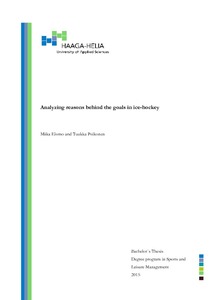Analyzing reasons behind the goals in ice-hockey
Elomo, Miika; Poikonen, Tuukka (2015)
Elomo, Miika
Poikonen, Tuukka
Haaga-Helia ammattikorkeakoulu
2015
All rights reserved
Julkaisun pysyvä osoite on
https://urn.fi/URN:NBN:fi:amk-2015060312062
https://urn.fi/URN:NBN:fi:amk-2015060312062
Tiivistelmä
Much of the conventional wisdom in ice hockey suggests that moving the puck forward,
towards the opponent's goal, is the best strategy for producing goals.
Past research has lent credence to this wisdom. Studies have consistently shown that
scoring chances in hockey are produced from turnovers and short possessions of less
than 10 seconds.
In this research-oriented thesis analyzing methods are what has happened before scoring
a goal and find out the “true” reasons behind the goals scored in SM-League.
Many coaches in Finland over preach a brand of hockey that puck control is smarter
gameplan than constant forward motion.
History shows that teams exchange the puck back and forth until someone commits a
fatal error and a goal is scored.
Previous studies have given only a partial picture of the nature of scoring. They have
implied that the production of a chance is dependent only on the possession immediately
prior to that chance.
This reseach is using all the different game situations involved in a game for finding
the reason behind the goals.
Goals scored in rushes are broken down in six categories,
Goals scored in turnovers are broken down in three categories,
Goals scored on offensive zone play are broken down in six categories,
Power play goals are broken down in seven categories and
Special situation goals are broken down in three categories
towards the opponent's goal, is the best strategy for producing goals.
Past research has lent credence to this wisdom. Studies have consistently shown that
scoring chances in hockey are produced from turnovers and short possessions of less
than 10 seconds.
In this research-oriented thesis analyzing methods are what has happened before scoring
a goal and find out the “true” reasons behind the goals scored in SM-League.
Many coaches in Finland over preach a brand of hockey that puck control is smarter
gameplan than constant forward motion.
History shows that teams exchange the puck back and forth until someone commits a
fatal error and a goal is scored.
Previous studies have given only a partial picture of the nature of scoring. They have
implied that the production of a chance is dependent only on the possession immediately
prior to that chance.
This reseach is using all the different game situations involved in a game for finding
the reason behind the goals.
Goals scored in rushes are broken down in six categories,
Goals scored in turnovers are broken down in three categories,
Goals scored on offensive zone play are broken down in six categories,
Power play goals are broken down in seven categories and
Special situation goals are broken down in three categories
